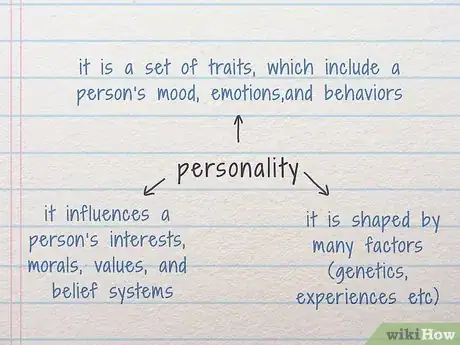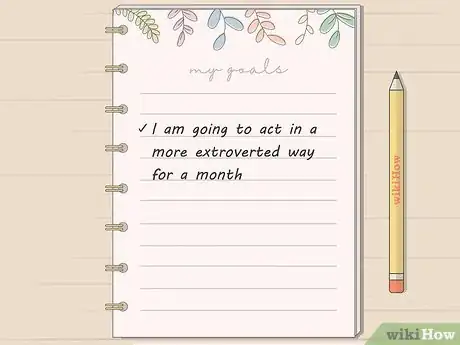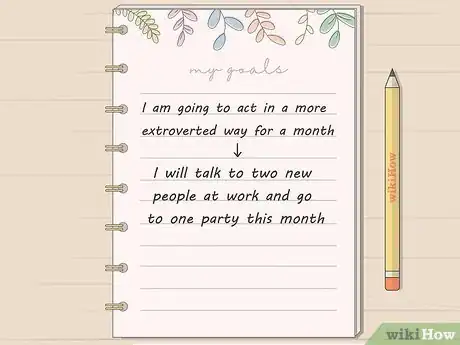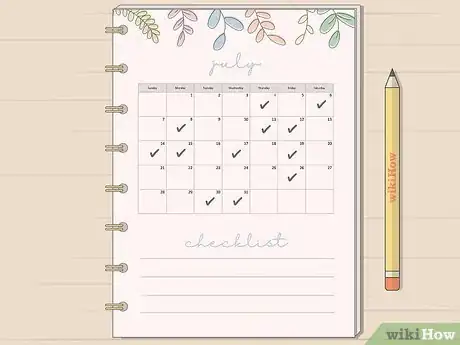This article was co-authored by Karuna Jain, MS. Karuna Jain is a Life Coach, Energy Healer, and the Owner of the Karuna Healing Center based in the San Francisco Bay Area. With more than 13 years of experience, she specializes in helping others heal through life coaching, hypnotherapy, reiki healing, pranic healing, and crystal healing. Karuna attended the Hypnosis Motivation Institute to receive her Hypnotherapy Certification. She also has a Life Coach Certification through the American Union of NLP.
There are 9 references cited in this article, which can be found at the bottom of the page.
This article has been viewed 57,614 times.
Your personality is at the core of who you are. It is what you use to identify yourself, and relate to others.[1] There may be things about your personality that you find appealing, and things that you are less happy with. If you are looking to change your personality, research shows that it can be done if you are committed. When making major personality changes, you should define the personality that you want to create, design a plan to get you there, and enjoy the new lifestyle that goes along with a different personality.[2]
Steps
Defining an Ideal Personality
-
1Define personality. Prior to identifying your own personality or the personalities of others, you must understand its foundational meaning. Personality is a set of traits, which include a person's mood, emotions, and behaviors. These traits should be pretty stable and consistent prior to labeling yourself or someone else with a particular personality. Your personality can affect both your mood and emotional responses.
- Your personality will affect your self-esteem, and it can also influence your interests, morals, values, and belief systems. A person’s identified personality is shaped by many factors, such as genetics, and personal experiences ( i.e., trauma, parenting, developmental history, etc.), including your belief system.[3]
-
2Learn the big five personality traits. In order to create a new personality, you will have to be able to evaluate your current personality and define the new personality you want. To do this, you will need to understand what traits define a personality. The big five personality traits recognized by most psychologists are:[4]
- Neuroticism
- Extroversion
- Openness
- Agreeableness
- Conscientiousness
Advertisement -
3Learn about personality stability. Understand that an individual's personality is usually much more consistent and stable than their mood or emotions. However, with conscious awareness and effort, it can be changed. A person’s personality is also subject to change as they mature through different phases of life, and as they go through life experiences. For instance, someone who exhibits more of an extroversion personality may become more introverted. If you have a personality that you feel needs changes for improvement, your best strategy is working with a psychotherapist. The psychotherapist will be able to help you identify certain traits you want to change, enhance problem-solving capacities, self-representation, and self-regulation to help you make the positive changes you wish to see in your personality.
- Some of the psychotherapeutic modalities used during psychotherapy sessions include cognitive behavioral therapy (CBT), and dialectical behavioral therapy (DBT).
-
4Assess your personality. To make a change in your personality, you will need to have an objective look at your current traits. Rate yourself on each of the big five personality traits. This will give you a baseline for any changes you want to make.[5]
- Take a standardized tests to rate yourself on the big five personality traits.
- See a mental health professional for more accurate results. Personality tests are common and frequently used tools with psychotherapists. It allows the psychologist and yourself to fully capture your personality, and work as a team to address any areas of concern you would like to change. These tests are much more detailed and accurate than those you would find online. Some of the more common personality tests used by psychotherapists include:
- Meyers-Briggs Type Indicator
- Minnesota Multiphasic Personality Inventory
- Rorschach Inkblot Test
- Keirsey Temperament Sorter
-
5Identify the changes you would like to see. Once you have rated yourself on each of the personality traits, decide which ones you want to see change. You may want to express more of one personality trait and less of another. Make a list of which traits you want to change and in what way you want them to change.[6]
- For example, you might decide that you want to be more agreeable and less neurotic.
- As you make changes, you may feel the need to retest your personality. Try to use the same test that you used initially so that you can accurately compare the two results.
Developing a Plan
-
1Make specific goals.[7] Avoid setting vague goals such as, “I’m going to change.” This sets you up for failure, since you have no way to measure the success that you’ve had. Instead, set a goal that is specific enough to know when you’ve accomplished it.[8]
- For example, you might have a goal like, “I am going to act in a more extroverted way for a month.”
-
2Create actionable steps to meet your goals. Once you have a goal, you need a path to reach it. This path should be made of actionable steps. Write these plans or steps down so you can keep track of your progress, what works for you and what doesn't work as you go along. These steps are things that you can actually do, not just plan.[9]
- For example, if your goal is to be more extroverted for a month, you might make steps like, “I will talk to two new people at work and go to one party this month.”
-
3Track your goals. Once you start working on your new personality, you’ll want to know how effective the changes are. You should track each specific goal by keeping record of your actionable steps and their outcomes. You can also track your overall progress by re-evaluating where your new personality falls on the big five personality traits.[10]
- For example, you could mark on a calendar each time you attend a social event or talk to a new person. This will let you keep track of how well you are doing at being more extroverted.
- Another option is to keep a journal of all of your goals. Such as, those goals that you have achieved, and those that you are continuing to work towards. Detail the steps that you are making to achieve those goals, and those specific experiences, people, or things, that help you stay accountable and on track.
-
4Acknowledge progress. Even if progress is slow, you should keep a positive attitude about your goals. To do this, you have to celebrate little victories. You shouldn’t give up just because you weren’t the life of the party in the first month. Instead, give yourself credit for having gone to the party in the first place.[11]
Living a New Lifestyle
-
1Change how you identify your personality. How you see yourself is an important part of your personality.[12] By believing that you are introverted, you may shy away from social activities. On the flip side, identifying yourself as an extrovert may can encourage you to go out and interact with people.<[13]
- You can affirm this identity by being sure to repeat it to yourself daily. You can also visualize yourself as being this new person.
- Another way to affirm the identity is to take another personality test and see how your scores have changed over time.
-
2Form habits that are consistent with the personality change. A personality change is only permanent if you continue to work at the changes. That means you will need to form habits that reinforce the personality that you have created. These will likely do simple, daily routines instead of major events.[14]
- For example, if you’ve decided to be more conscientious, you could take time to meditate each day and be present in the moment.
- Another consideration is to be mindful of the environment you put yourself in. Place yourself in environments that are in line with the personality you would like to reflect. Avoid hanging around people who reflect the opposite of the personality you would like to adopt. Develop connections and friendships with people who will help you through your personality change process. These friends should be reliable and available for you when you need them. They will help motivate you during times of challenge.
-
3Continue to learn and grow. Throughout the course of life, everyone changes. Even once you create your new personality, it will be subject to change. This is not a bad thing. The changes that your personality goes through are generally a result of growth and maturity.[15]
References
- ↑ Karuna Jain, MS. Life Coach & Energy Healer. Expert Interview. 23 November 2021.
- ↑ Karuna Jain, MS. Life Coach & Energy Healer. Expert Interview. 23 November 2021.
- ↑ Karuna Jain, MS. Life Coach & Energy Healer. Expert Interview. 23 November 2021.
- ↑ https://blogs.psychcentral.com/childhood-neglect/2015/01/the-5-essential-steps-to-change-a-personality-trait/
- ↑ https://blogs.psychcentral.com/childhood-neglect/2015/01/the-5-essential-steps-to-change-a-personality-trait/
- ↑ https://greatergood.berkeley.edu/article/item/can_your_personality_change_over_your_lifetime
- ↑ Karuna Jain, MS. Life Coach & Energy Healer. Expert Interview. 23 November 2021.
- ↑ https://inside.ewu.edu/calelearning/psychological-skills/goal-setting/
- ↑ https://greatergood.berkeley.edu/article/item/seven_ways_to_find_your_purpose_in_life
- ↑ https://blogs.psychcentral.com/childhood-neglect/2015/01/the-5-essential-steps-to-change-a-personality-trait/
- ↑ https://positivepsychology.com/self-acceptance/
- ↑ Karuna Jain, MS. Life Coach & Energy Healer. Expert Interview. 23 November 2021.
- ↑ https://www.universityofcalifornia.edu/news/can-you-change-your-personality
- ↑ https://learningcenter.unc.edu/tips-and-tools/changing-habits/
- ↑ https://www.psychologytoday.com/blog/media-spotlight/201509/can-you-change-your-personality







































































